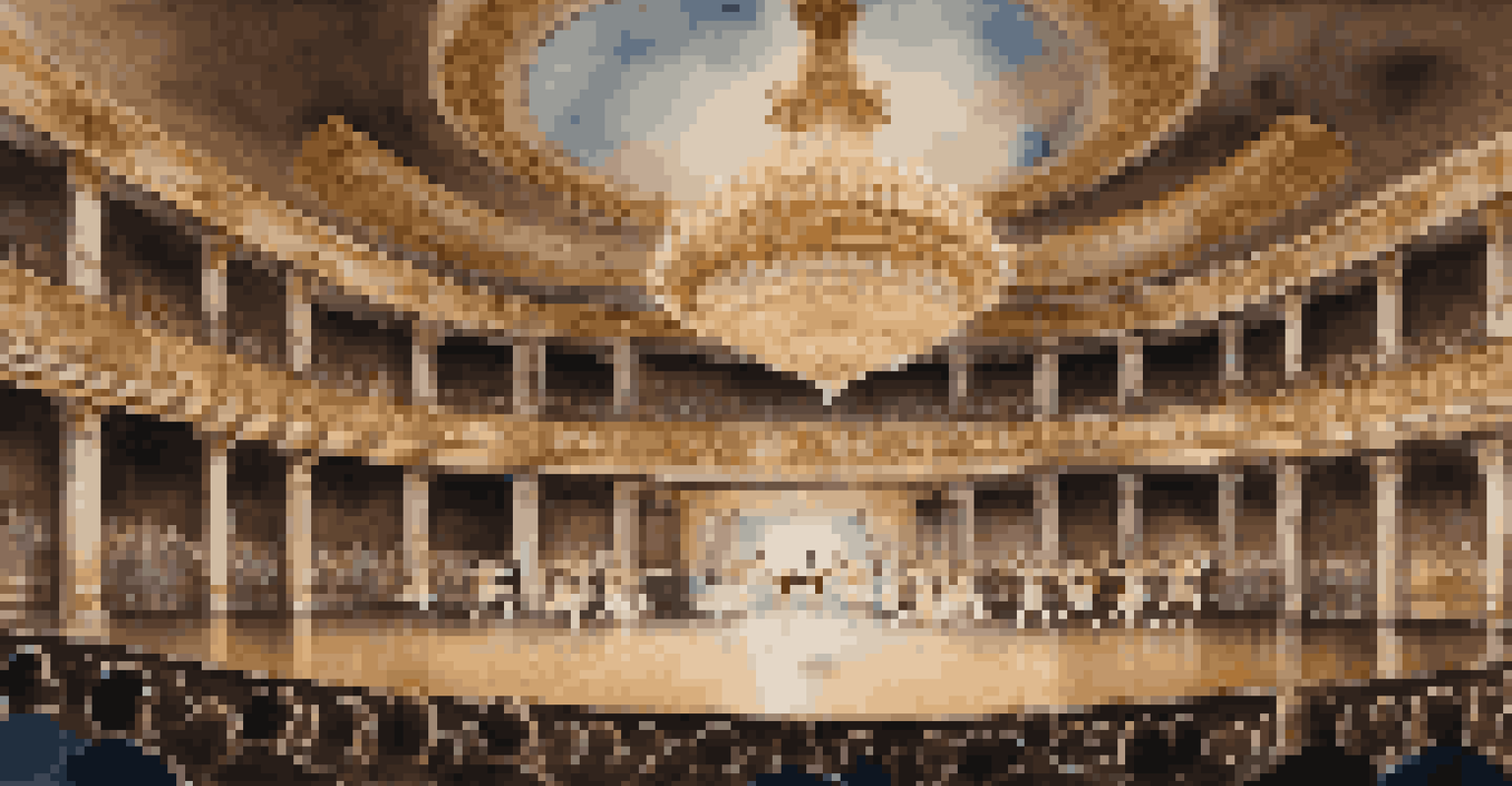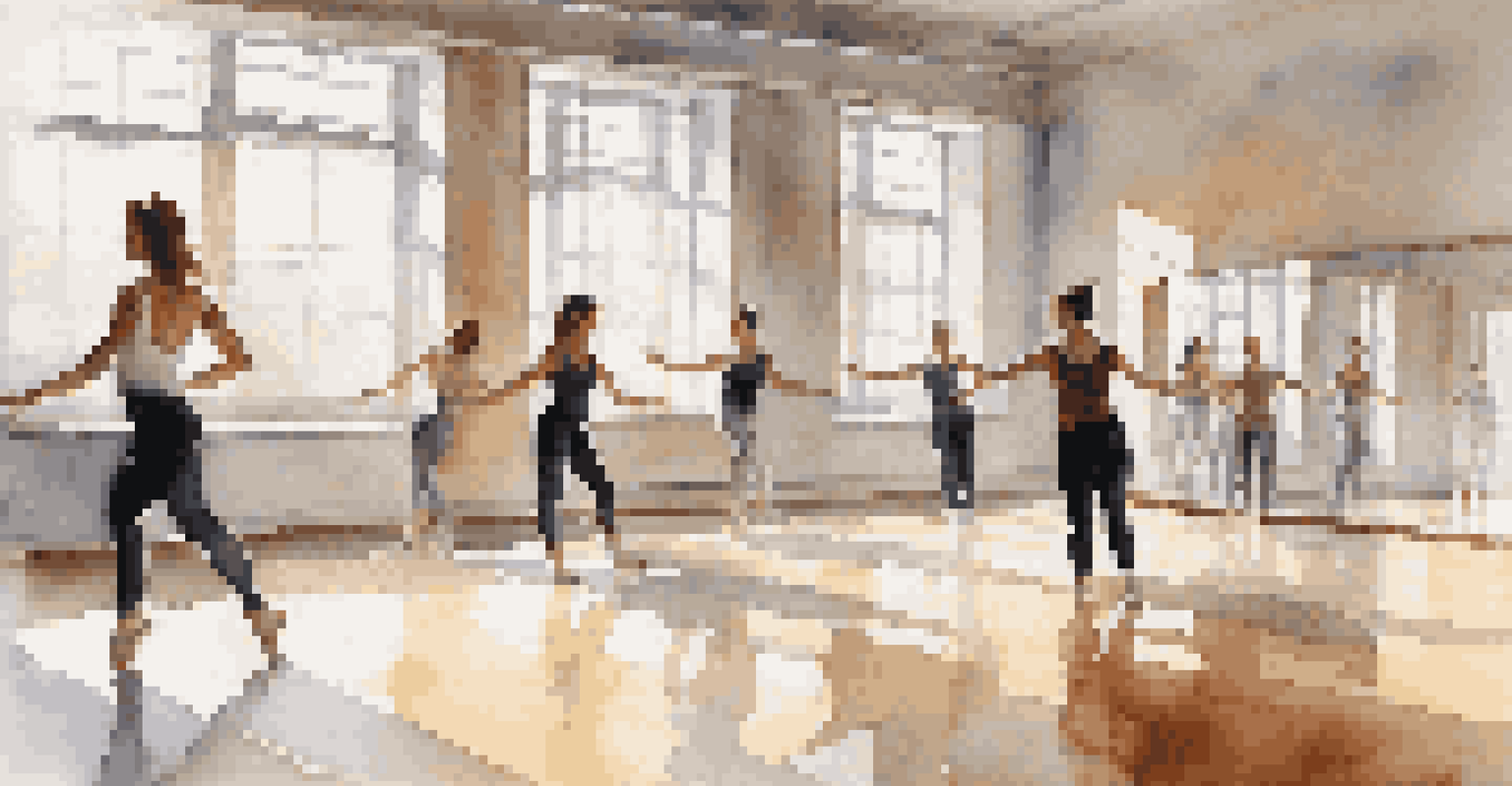The Relationship Between Choreography and Costume Design

Understanding the Role of Choreography in Dance
Choreography is the art of creating dance movements and sequences. It shapes the visual storytelling of a performance, guiding how dancers express emotions and themes through their bodies. Think of it as the blueprint of a building, outlining how everything will come together in a cohesive manner.
Dance is the hidden language of the soul.
Every dance piece tells a story, and choreography is the vehicle that drives this narrative. It considers the rhythm, style, and intent behind the movements, allowing the dancers to connect with the audience on a deeper level. This connection is crucial; without it, the performance can feel flat, leaving audiences disengaged.
Moreover, effective choreography not only focuses on individual movements but also on how those movements interact with the overall performance environment. This is where costume design begins to play an essential role, as the right attire can enhance or detract from the choreography's impact.
The Importance of Costume Design in Dance
Costume design is more than just dressing the dancers; it’s an integral part of the storytelling process. Costumes help to define characters, set the mood, and enhance the overall aesthetic of the performance. Imagine a ballet dancer in a flowing, ethereal dress versus one in a tight, modern outfit; the visual impact is dramatically different.

Additionally, costumes can influence how dancers move. A well-designed outfit allows for fluidity and grace, while poorly constructed costumes can restrict movement, ultimately affecting the choreography. For instance, a dancer in a heavy costume may struggle with jumps that are effortless in a lighter outfit.
Choreography Shapes Dance Narratives
Choreography is essential for expressing emotions and driving the narrative of a dance performance.
The color, texture, and style of a costume also serve to complement the choreography. A vibrant, colorful costume can draw attention to specific movements, highlighting the emotion behind them. This synergy between choreography and costume design is what creates a memorable and captivating performance.
How Choreography and Costume Design Collaborate
The collaboration between choreographers and costume designers is vital to the success of a performance. These two creative forces must work in tandem, sharing ideas and visions to achieve a unified artistic expression. This partnership can start early in the creative process, allowing for a seamless blend of movement and attire.
The costume must be an extension of the character's personality and the story being told.
For instance, a choreographer might design a dance that requires specific movements that are best suited for certain fabrics or styles. Conversely, a costume designer may create garments that inspire new choreography by suggesting unique ways to move. This back-and-forth can lead to innovative ideas and unexpected surprises.
Ultimately, the relationship between choreography and costume design is a dialogue. Each discipline informs the other, leading to a richer, more immersive experience for the audience. When both elements are in harmony, the performance transcends mere entertainment, becoming a work of art.
Historical Context: Choreography and Costume Design
Throughout history, the relationship between choreography and costume design has evolved significantly. In classical ballet, for example, elaborate costumes were often used to convey status, character, and the story’s time period. These costumes were meticulously crafted to enhance the beauty of the dancer’s movements.
In more contemporary dance forms, such as hip-hop or modern dance, costume choices reflect cultural influences and personal expression. Dancers often wear streetwear that aligns with the music and the choreography, creating a visual representation of their individuality. This shift highlights how changing societal norms have influenced the aesthetics of dance.
Costumes Enhance Dance Expression
Costume design is crucial in defining characters and influencing how dancers move, thereby enhancing the overall storytelling.
Understanding this historical context allows us to appreciate how choreography and costume design are not just art forms but also reflections of cultural evolution. They tell us about the times we live in and how artistic expression adapts and transforms over the years.
Case Studies: Successful Collaborations
One notable example of successful collaboration between choreography and costume design is the work of Martha Graham and her designer, Halston. Their partnership resulted in groundbreaking pieces that changed the landscape of modern dance. The costumes were innovative, allowing for freedom of movement while still being visually striking.
Another great example is the Broadway production of 'Hamilton,' where the choreography and costumes work in perfect harmony to tell the story of America's founding. The modern attire worn by the cast juxtaposes historical narratives, allowing audiences to connect with the characters on a personal level. This synergy is what gives the show its unique flair.
These case studies illustrate that when choreographers and costume designers collaborate effectively, the result can be nothing short of magical. The performance becomes a multi-dimensional experience, engaging audiences both visually and emotionally.
The Impact of Technology on Choreography and Costume Design
In recent years, technology has significantly influenced both choreography and costume design. Innovations such as 3D printing have allowed costume designers to create intricate designs that were once impossible to achieve. This technology enables artists to push boundaries, resulting in costumes that enhance the choreography in exciting new ways.
Choreographers, too, are embracing technology. Video analysis tools allow them to refine movements and experiment with different formations. For instance, choreographers can record rehearsals to analyze timing and spacing, making it easier to synchronize dance with music and costumes.
Collaboration Fuels Creative Success
The partnership between choreographers and costume designers leads to innovative performances that are visually and emotionally captivating.
As technology continues to evolve, the possibilities for choreography and costume design seem limitless. The integration of digital elements can even lead to hybrid performances that combine live dance with virtual or augmented reality, creating immersive experiences that captivate audiences.
Future Trends in Choreography and Costume Design
Looking ahead, one trend is the increasing emphasis on sustainability in costume design. As awareness of environmental issues grows, designers are exploring eco-friendly materials and practices. This shift not only benefits the planet but also inspires choreographers to create movements that reflect this ethos.
Additionally, the rise of diverse dance forms and cultural influences is shaping choreography and costume design. Artists are increasingly drawing from a variety of styles, leading to innovative fusions that celebrate global traditions. This melting pot of ideas encourages creativity and collaboration.

As we move forward, the relationship between choreography and costume design will likely continue to evolve, reflecting broader societal changes. Embracing these trends will ensure that performances remain relevant, engaging, and inspiring for future generations.